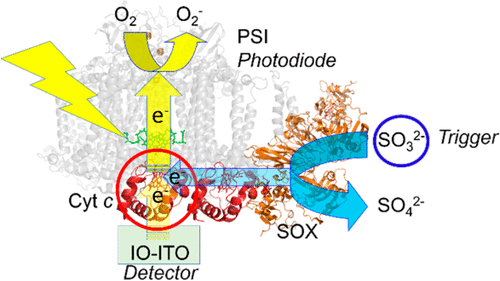当前位置:
X-MOL 学术
›
J. Am. Chem. Soc.
›
论文详情
Our official English website, www.x-mol.net, welcomes your feedback! (Note: you will need to create a separate account there.)
Bioelectronic Circuit on a 3D Electrode Architecture: Enzymatic Catalysis Interconnected with Photosystem I
Journal of the American Chemical Society ( IF 15.0 ) Pub Date : 2017-11-14 00:00:00 , DOI: 10.1021/jacs.7b10161 Dmitri Ciornii 1 , Marc Riedel 1 , Kai R. Stieger 1 , Sven C. Feifel 1 , Mahdi Hejazi 2 , Heiko Lokstein 3 , Athina Zouni 2 , Fred Lisdat 1
Journal of the American Chemical Society ( IF 15.0 ) Pub Date : 2017-11-14 00:00:00 , DOI: 10.1021/jacs.7b10161 Dmitri Ciornii 1 , Marc Riedel 1 , Kai R. Stieger 1 , Sven C. Feifel 1 , Mahdi Hejazi 2 , Heiko Lokstein 3 , Athina Zouni 2 , Fred Lisdat 1
Affiliation

|
Artificial light-driven signal chains are particularly important for the development of systems converting light into a current, into chemicals or for light-induced sensing. Here, we report on the construction of an all-protein, light-triggered, catalytic circuit based on photosystem I, cytochrome c (cyt c) and human sulfite oxidase (hSOX). The defined assembly of all components using a modular design results in an artificial biohybrid electrode architecture, combining the photophysical features of PSI with the biocatalytic properties of hSOX for advanced light-controlled bioelectronics. The working principle is based on a competitive switch between electron supply from the electrode or by enzymatic substrate conversion.
中文翻译:

3D电极体系结构上的生物电子电路:酶催化与光系统I互连
人造光驱动信号链对于开发将光转换为电流,化学物质或光感测系统的开发尤为重要。在这里,我们报告基于光系统I,细胞色素c(cyt c)和人亚硫酸盐氧化酶(hSOX)的全蛋白,光触发催化电路的构建。使用模块化设计对所有组件进行定义的组装,将形成一种人工生物混合电极架构,将PSI的光物理特征与hSOX的生物催化特性相结合,从而实现了先进的光控生物电子技术。工作原理基于从电极提供的电子或通过酶促底物转化之间的竞争性转换。
更新日期:2017-11-16
中文翻译:

3D电极体系结构上的生物电子电路:酶催化与光系统I互连
人造光驱动信号链对于开发将光转换为电流,化学物质或光感测系统的开发尤为重要。在这里,我们报告基于光系统I,细胞色素c(cyt c)和人亚硫酸盐氧化酶(hSOX)的全蛋白,光触发催化电路的构建。使用模块化设计对所有组件进行定义的组装,将形成一种人工生物混合电极架构,将PSI的光物理特征与hSOX的生物催化特性相结合,从而实现了先进的光控生物电子技术。工作原理基于从电极提供的电子或通过酶促底物转化之间的竞争性转换。


























 京公网安备 11010802027423号
京公网安备 11010802027423号